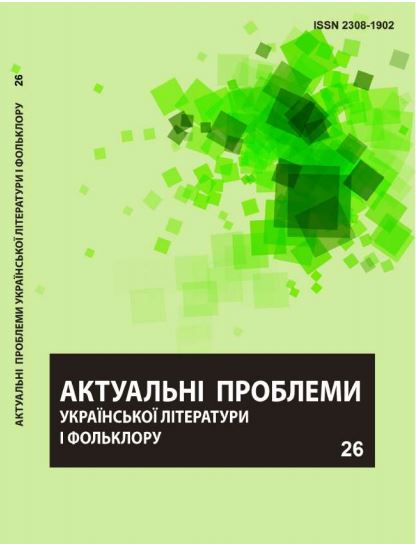Features of the chronotope by M. Khvylovy "Sentimental history" and its film version "Back to shame!".
DOI:
https://doi.org/10.31558/2308-1902.2018.26.7Keywords:
time, space, chronotope, city, village, adaptation, cinema interpretationAbstract
The article reveals the peculiarities and means of organizing artistic time space in the novel by M. Khvylovy "Sentimental History" and its film version "Back to shame!". The study summarizes the scholars' arguments about the chronotope, determines its dominant, and the peculiarities of the time-spatial organization of "Sentimental History". At the same time, the author of the article gives her own assessment of the problem, substantiating the idea of the close relationship of time-space coordinates by observing the story.
In the work, the story and its adaptation on the time-space level are compared. The article focuses on the means of organization of the chronotope both in the film and in the work of art, the common and distinctive features were revealed, the author's concept of the writer and director was clarified. It is determined that in connection with the fact that the story is based on the opposition, internal conflicts that arise in the mind of the narrator, therefore the reflection of certain facts in the work is veiled, and sometimes it is difficult to establish its time-space boundaries. It was found that in the film they are more visible and understandable to the viewer, because the cinematographers not only successfully visualized through the installation, change of personnel all the events, but also "discovered" the hidden parts of the first creation. In the film, unlike the story, the color of the depicted epoch is brightly colored, the emphasis is on the attributes of the day, revealing the details hidden by the writer. The paper shows comparison the means which apply in the same way in both writing, for example, application of taking, which not only helps to organize the time space, but also conveys the individual peculiarities of author's thinking.
References
Бахтин М. Формы времени и хронотопа в романе. СПб. : Азбука, 2000. 304 с.
Богданова О. Місто Харків як рушійна та руйнівна сила у творах Миколи Хвильового (на матеріалі повісті «Сентиментальна історія»). Актуальні проблеми слов’янської філології. 2011. Вип. XXIV, ч. 1. С. 248–254.
Кононенко Т. Місто як текст: освоєння урбаністичного простору як ключ до творення тексту в романах А. Картер та Дж. Вінтерсон. Слово і час. 2007. № 7. С. 34–41.
Копистянська Н. Художній час як категорія порівняльної поетики. К. : Наукова думка, 1993. С.184–200.
Кухаренко В. Інтерпретація тексту. Вінниця : Нова книга, 2004. 272 с.
Лотман Ю. В школе поэтического слова. М.,1988. С. 260–265.
Муратов О. Фільм «Геть сором!». К., 1994.
Нестерик Э. Свойства и функции социального пространства в художественном тексте. Молодой ученый. 2016. №1. С. 891–895.
Хвильовий М. Новели, оповідання «Повість про санаторійну зону», «Вальдшнепи». Роман. Поетичні твори. Памфлети. К. : Наук. думка, 1995. 816 с.

